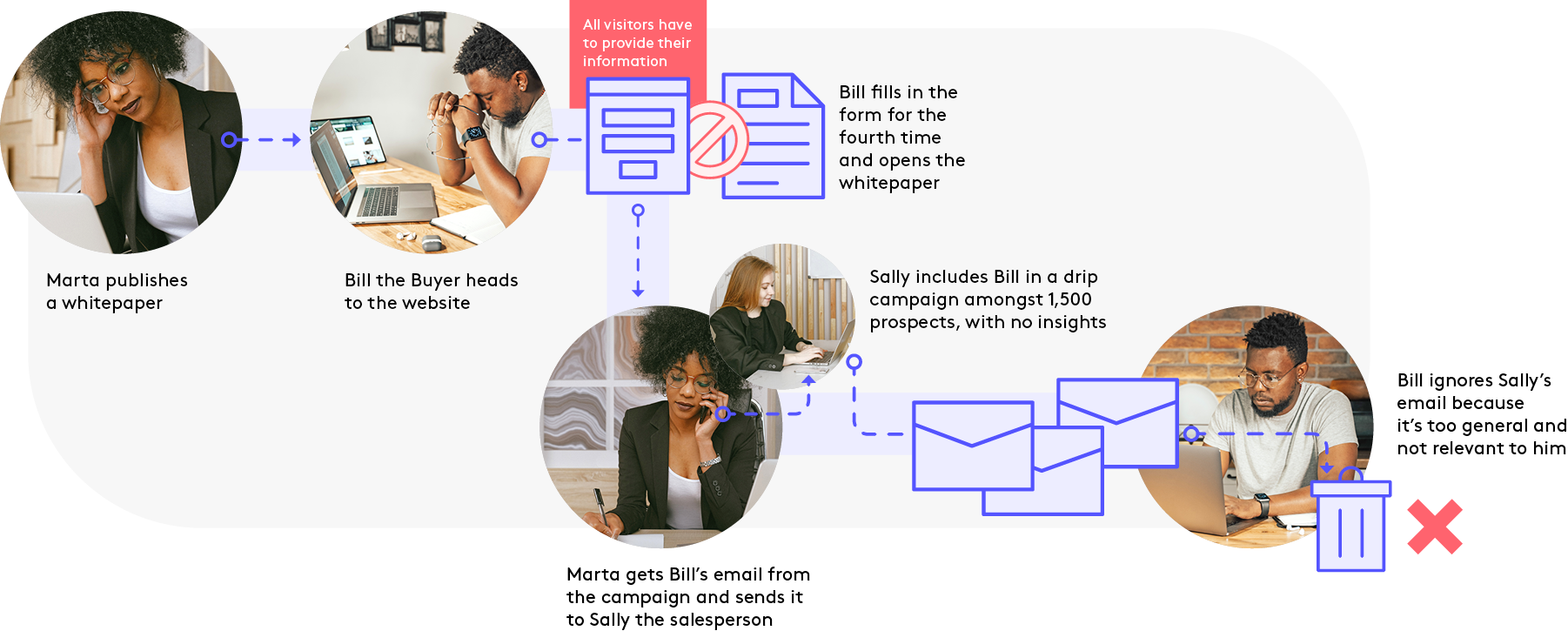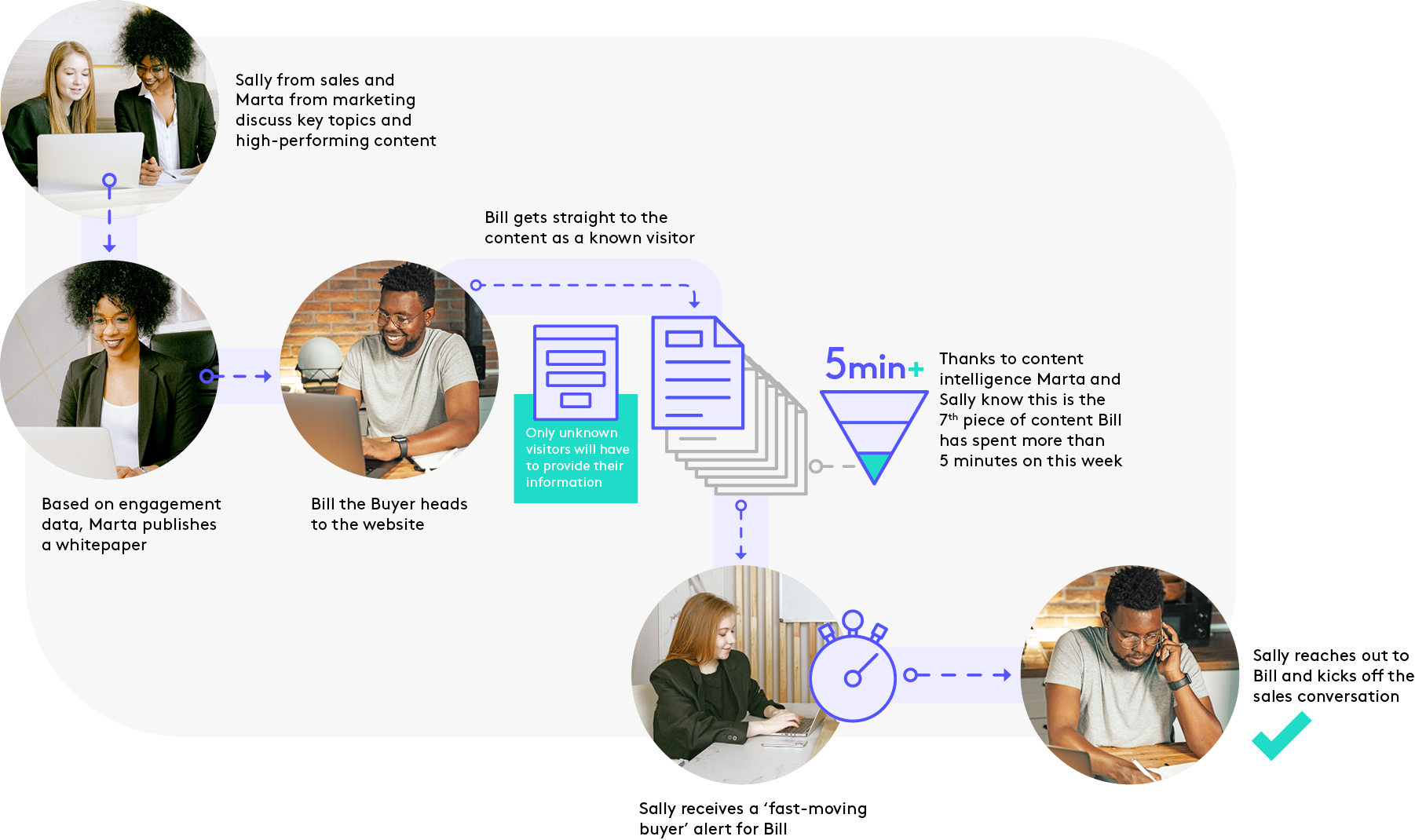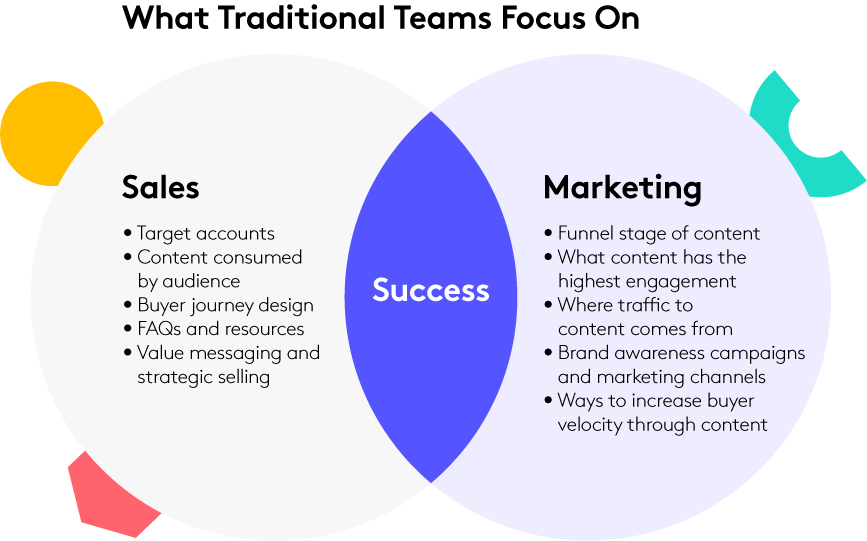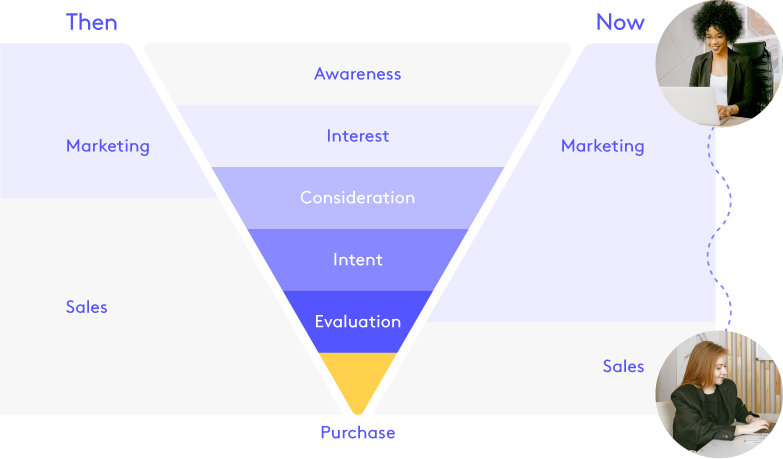
Bridging The Sales and Marketing Gap
The best way to get sales and marketing teams on the same page? Content intelligence.
One of the biggest blockers to a company’s success is a lack of alignment between teams. Top industry analysts like Forrester have been following this disconnect for years, and found that highly aligned companies grow 19% faster and are 15% more profitable. The proof is in the numbers: businesses, and in particular sales and marketing teams, can’t continue working in silos when they are both working towards the same revenue goals. It’s time to start taking a unified approach to the marketing and sales orgs at your company.
If your sales and marketing orgs aren’t focused on the same prize, you risk misalignment and a lack of communication that can disconnect an entire company. In their own ways, both teams are responsible for bringing in the same revenue, but businesses are wasting upwards of $1 trillion dollars annually due to lack of coordination.
“When Sales and Marketing are aligned, clear boundaries between the two exist, but they’re flexible. The groups engage in joint planning and training. The sales group understands and uses marketing terminology such as “value proposition” and “brand image.” Marketers confer with salespeople on important accounts.”
The obstacles that keep sales and marketing misaligned aren’t intentional. It all boils down to a communication gap between teams—and content intelligence is the way to bridge this gap.
Consider the journey of a lead in two scenarios, one that doesn’t use content intelligence, and one that does:
Scenario #1 — Without Content Intelligence

Marta, a Content Marketer, just finished writing a killer whitepaper. Her company uses a form-gating strategy to collect leads, so she sets the form up, hits publish, and waits for the leads to pour in. Marta gets a few email addresses of people who read her blog post, then she tosses those leads over to Sally the Salesperson who takes it from there. That’s it. That’s the scenario.
Marta has no idea if her content can be attributed to revenue or closed deals; she doesn’t even know if her content is helping move people through the buyer journey. When it comes to the lead hand-off, she doesn’t have much information to provide to Sally, other than the email address, name, and company of the person who filled out the form. Neither will ever know if the prospect ended up finishing (or even starting) the whitepaper. Sally is going to take action with very little insight into the hot topic that will resonate with the lead.
Scenario #2 —With Content Intelligence
Marta finishes up her whitepaper, but this time added a conditional form strategy which means only unknown visitors will have to provide their information, while known visitors can read the content freely. Bill the B2B Buyer is looking to purchase some new software and Marta’s company is on the shortlist of software companies he’s researching. He heads over to their website and spots Marta’s new whitepaper. He clicks through and starts reading—Bill’s already been to the site a few times, so he’s a known visitor and doesn’t have to fiddle with a form. Both Marta and Sally have been keeping an eye on Bill, and notice that this is the 7th piece of content he’s read this week, and the third visit where he’s read more than one asset.
Using content intelligence, Sally can see that the content Bill’s engaging with are bottom of the funnel pieces, and he’s spending over 5 minutes reading each asset. On top of that, Sally can see that over the past two weeks, two of Bill’s colleagues have started to peruse other blog posts Marta has written. Because of the pace Bill is moving throughout his research stage, Sally receives a ‘fast-moving buyer’ alert which means Bill’s showing sales readiness signals. Sally reaches out to Bill and kicks off the sales conversation.
In the first scenario, marketing is focused on generating MQLs to pass to sales, and sales is just focused on closing the deals. In the second scenario, the two colleagues are working towards the same goals, using the same data, and speaking the same language. The misalignment here is the lack of communication between what the B2B buyers are going through, and how sales and marketing both have valuable insights on the buying process that can help the other team.
Consider the knowledge that’s living inside the brains of sales and marketing teams—then imagine the possibilities if these teams shared information and tools to understand their prospects better. Sounds dreamy!
Deep dive: three ways content intelligence can bridge your go-to-market team communication gap
Consider your traditional sales and marketing funnel, where the sales team is largely responsible for everything from consideration through to purchase. Over the last few years, content has taken the front seat and buyer self-education is the new normal. DemandGen’s ‘New Sales and Marketing Funnel’ paints a picture of just how much the traditional approach to the buyer journey has changed:
Considering content is king (or queen) of the buyer journey, marketing now takes a bigger role in velocity and value of deals in the sales funnel. In fact, according to DemandGen’s buyer process timeline the first eight steps of the buyer process include consuming content and research individually. By the time a sales rep even makes contact with the prospect, the majority of the buying process is over. It begs the question: do you think your content is good enough to carry a prospect three quarters of the way through their buyer journey?
Content intelligence answers that question because it provides you with deeper insight into every touchpoint your prospect has with your brand—from the first time they land on your page and read a piece of content, to the final purchase stage of the sales funnel. PathFactory customers have been using content intelligence for years at every stage of their buyer journeys, and both their sales and marketing teams have seen results.
Content intelligence has helped PathFactory customers:
1. Streamline and standardize lead gen efforts.
While many companies rely on email drip campaigns to get their content out there, without content intelligence it’s hard to know if your customers engage with your content beyond clicking the link in the email. For a company that uses lead scoring to find the best MQLs, the lack of information about prospects can be an obstacle when trying to find high-quality leads.
Using PathFactory, TIBCO changed the way they were gathering leads, and by doing this could also standardize how they scored them, resulting in richer information about prospective customers. By doing so, they saw a 5x lift in opportunities, and an increase of 27% in their MEL to MQL conversion rate.
2. Know when prospects are ready to purchase.
Instead of having sales people that go into calls blindly, content intelligence arms your sales team with insights about the topics and resources prospects are interested in and have already consumed. If you know someone spent hours bingeing content about topic tags, you’ll know to bring it up in your outreach call. Talk about competitive advantage!
PathFactory customer Bazaarvoice used content intelligence when they were launching a new ABM approach to lead generation. By using PathFactory, they aligned their sales and marketing teams, and started sharing insights that included account- and individual-level data. They used this data to seek out accounts that were already showing high intent to purchase, and began focusing on finding high quality MQAs vs. MQLs. By using PathFactory, Bazaarvoice saw a 57% increase in opportunities created and a 129% increase in pipe gen.
3. Share sales and marketing efforts during the post-sales phase.
Promoting your content shouldn’t end once a prospect becomes a paying customer; in fact, customer marketing is a crucial step to getting your new customers feel engaged during the onboarding process.
PathFactory customer Cisco knew that their customers were 80% more likely to realize the full value of products (and eventually renew) when product adoption happened in the first 30 days. Through customer marketing in the post-sales process, Cisco began serving up post-sales content to their 300,000+ partners, which boosted their customer adoption by 3.5x! By combining sales’ information about customer adoption, and marketing’s eye for content, you’ll be able to provide a post-sales marketing experience to your customers that maximizes adoption and keeps them engaged.
It’s time to empower your sales and marketing teams to get on the same page
Start simple and think about how content intelligence can help your sales and marketing teams align in the following areas:
- Agree on ideal customer profiles (ICPs) and target accounts
- Marketing is the keeper of the content strategy, so it’s important to include them in conversations about ICPs and target account lists. Sharing the same data will help the team prioritize the right accounts at the right time.
- Develop a plan for handing off your ‘sales ready’ leads
- The journey to being ‘sales ready’ is one filled with content—content that was written and distributed by the marketing team. Decide as a larger team how to identify and approach prospects who are ready to purchase.
- Rethink your sales funnel
- If your customer journey doesn’t have both sales and marketing represented, it’s time to go back to the drawing board. Both teams should be working towards winning the same accounts and generating revenue.
- Align on goals and KPIs
- Some companies believe success metrics belong to either sales or marketing. Teams can have individual metrics, but it’s crucial to have goals that both teams can work towards, like SAL (sales-accepted leads), revenue, and opportunity-to-win ratio.
- Find ways to leverage your customer relationships
- Sales and marketing teams both stand to benefit from strong customer relationships. Whether it’s testimonials, customer case studies, or guest blogging, the opportunities created through customer advocacy are endless.
Sales and marketing alignment might seem like a giant undertaking, but ushering in this type of change boils down to providing teams the same data so they can communicate better with one another. With its focus on sales enablement and deep customer insights, content intelligence is the best way to empower both teams to begin working towards the same goals while speaking the same language.




